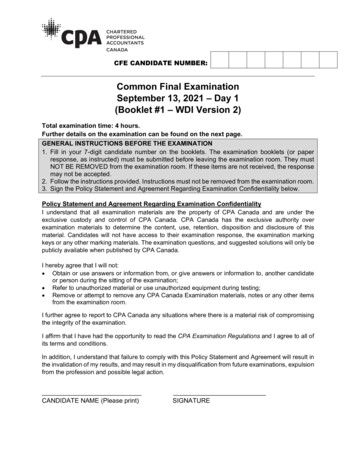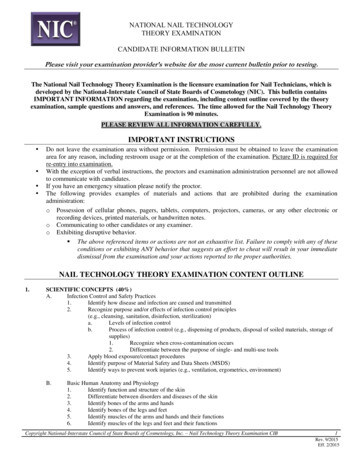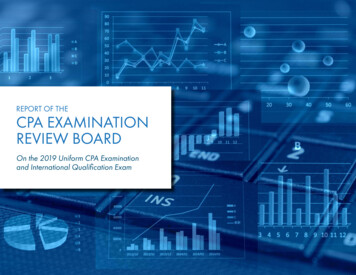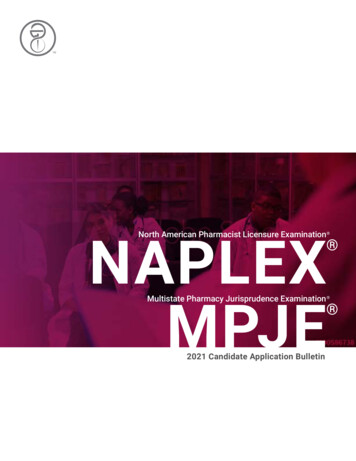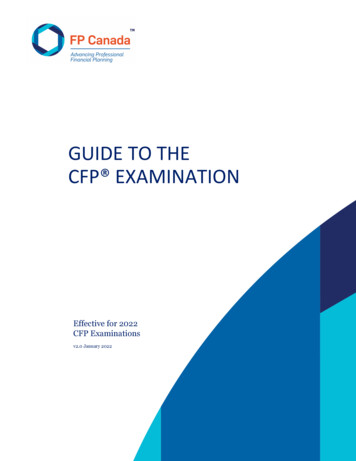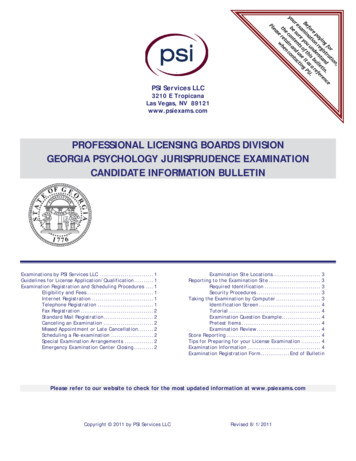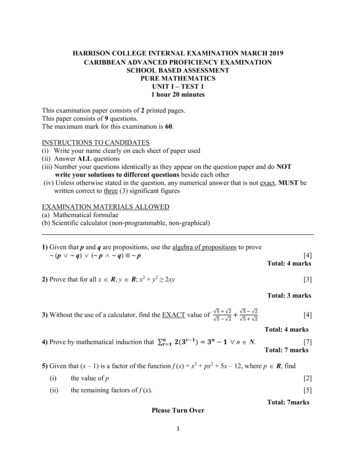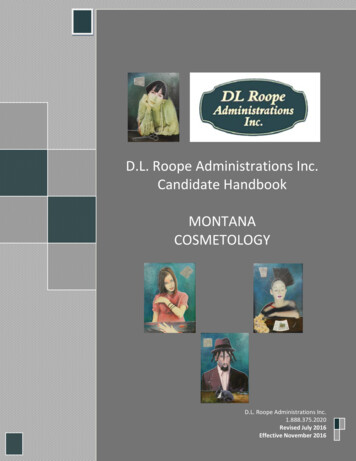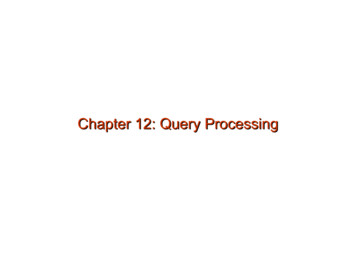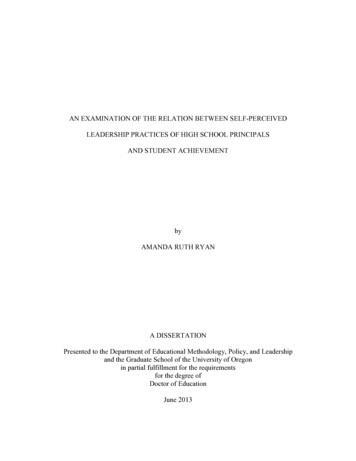
Transcription
AN EXAMINATION OF THE RELATION BETWEEN SELF-PERCEIVEDLEADERSHIP PRACTICES OF HIGH SCHOOL PRINCIPALSAND STUDENT ACHIEVEMENTbyAMANDA RUTH RYANA DISSERTATIONPresented to the Department of Educational Methodology, Policy, and Leadershipand the Graduate School of the University of Oregonin partial fulfillment for the requirementsfor the degree ofDoctor of EducationJune 2013
DISSERTATION APPROVAL PAGEStudent: Amanda Ruth RyanTitle: An Examination of the Relation Between Self-Perceived Leadership Practices ofHigh School Principals and Student AchievementThis dissertation has been accepted and approved in partial fulfillment of therequirements for the Doctor of Education degree in the Department of EducationalMethodology, Policy, and Leadership by:Dr. Gerald TindalDr. Keith HollenbeckDr. Edward Kame’enuiDr. Patricia A. GwartneyChairMemberMemberOutside MemberandKimberly Andrews EspyVice President for Research & Innovation/Dean of theGraduate SchoolOriginal approval signatures are on file with the University of Oregon Graduate School.Degree awarded June 2013ii
2013 Amanda Ruth Ryaniii
DISSERTATION ABSTRACTAmanda Ruth RyanDoctor of EducationDepartment of Educational Methodology, Policy, and LeadershipJune 2013Title: An Examination of the Relation Between Self-Perceived Leadership Practices ofHigh School Principals and Student AchievementThe current study explored the relation between the self-perceived leadershippractices of Portland Metro area high school principals (N 28) and the achievementlevels of Hispanic and non-Hispanic White high school students on the OregonAssessment of Knowledge and Skills (OAKS) high school math test. The LeadershipPractices Inventory (LPI) self-report was used to measure frequency of leadershippractices. Differential performance across categories of race and ethnicity were analyzedand compared against high school principal self-reported scores on the LPI. This studyexpanded on existing research by connecting principal leadership practices to studentachievement by subgroup with a focus on achievement of Hispanic and non-HispanicWhite students at the secondary level. Pearson product-moment correlation coefficientswere computed to assess the relation between the self-reported leadership practices ofhigh school principals and student proficiency category percentages. Multiple regressionswere used to determine the relative predictive nature of the practices of an exemplaryleader in relation to the percentage of Hispanic and non-Hispanic White students whoexceeded, met, or did not meet standards on the 2010-2011 OAKS high school math test.School demographic factors of percentage of students of color, percentage of studentsiv
receiving free or reduced price lunch (FRPL), and percentage of students enrolled inEnglish Language Learner (ELL) programs were also analyzed to determine if thesecontextual factors had an impact on leadership practices. Results support no predictivenature of student achievement on principal self-assessment of leadership practices nor dothey support a relation between school demographic factors and principal leadership.v
CURRICULUM VITAENAME OF AUTHOR: Amanda Ruth RyanGRADUATE AND UNDERGRADUATE SCHOOLS ATTENDED:University of Oregon, Eugene, OregonLewis and Clark College, Portland, OregonScripps College, Claremont, CaliforniaBarnard College, Columbia University, New York, New YorkDEGREES AWARDED:Doctor of Education, 2013, University of OregonMaster of Arts, Teaching, 2004, Lewis and Clark CollegeBachelor of Arts, Psychology and Art History, 1998, Scripps CollegeAREAS OF SPECIAL INTEREST:Educational LeadershipEducational EquityTeacher PreparationStudent LeadershipPROFESSIONAL EXPERIENCE:Art teacher, Hillsboro High School, Hillsboro, Oregon, 2004 to presentAdjunct faculty, Graduate School of Education, Pacific University, 2011 topresentDean of students, Hillsboro High School, Hillsboro, Oregon, 2010 to 2011Activities director, Hillsboro High School, Hillsboro, Oregon, 2006 to 2010vi
ACKNOWLEDGMENTSA special thank-you to committee chair Dr. Gerald Tindal and committee memberDr. Keith Hollenbeck for seeing me through to the very end. Thank you to my committeemembers Dr. Edward Kame’enui and Dr. Patricia A. Gwartney for their assistance in thepreparation of this manuscript. I also thank each of the high school principals whoparticipated in the study. Finally, I thank my cohort members for their consistent supportand encouragement.vii
Dedicated to my grandfather, Frank Herron Spears, who set the bar high, and to mymother, husband, and daughter for helping me to reach for it.viii
TABLE OF CONTENTSChapterPageI. INTRODUCTION .1Current Challenges Faced by School Leaders .2Changing Definitions of Principal Leadership .3II. LITERATURE REVIEW.6The Changing Role of the School Principal .7Research on Principal Leadership and Student Achievement Prior to theHigh-Stakes Accountability Movement.10Principal Leadership Impact on Student Achievement in the Context ofHigh-Stakes Accountability .13Analysis of the Use of Self-Report Surveys to Measure PrincipalLeadership Practices .29Linking School Leadership and Executive Leadership Research.30Summary of Leadership Review and Moving Forward.35III. METHODS .32Setting and Participants.37Research Design.37Description of Survey Design, Administration and Scoring .38Data Analysis .49IV. RESULTS .46Cases Included and General Description .46Question One: Analyzing the LPI Subtests for Multicollinearity.48Question Two: Predictive Nature of Performance Indicators.49ix
ChapterPageQuestion Three: Adding Non-Performance Variables to the Regression.51V. DISCUSSION .57Results Summary .57Limitations .58Question One: Analyzing the LPI Subtests for Multicollinearity.60Question Two: Predictive Nature of Performance Indicators.63Question Three: Adding Non-Performance Variables to the Regression.65Principal Tenure.67Implications.67Possibilities for Future Research .70Conclusions.70APPENDICES .72A. DEMOGRAPHICS FOR SAMPLED HIGH SCHOOLS .74B. PRINCIPAL SURVEY .77C. FIRST PRINCIPAL REQUEST E-MAIL .78D. SECOND PRINCIPAL REQUEST E-MAIL .79E. FINAL PRINCIPAL REQUEST E-MAIL.80F. DESCRIPTIVE STATISTICS FOR RESPONDENTS’ SELFRANKINGS ON EACH LPI ITEM, N 28 .81G. PEARSON CORRELATION OF RESPONSES TO INDIVIDUAL LPIQUESTIONS AND STUDENT ACHIEVEMENT SCORES.83REFERENCES CITED.85x
LIST OF TABLESTablePage1. Literature Search Process.62. Changing Concepts of Principal Leadership .93. Cronbach’s Alpha Analysis of Internal Reliability of the LeadershipPractices Inventory.424. Descriptive Statistics of OAKS Assessment Results, N 39.475. Descriptive Statistics of LPI Principal Self Assessment Scores, N 29 .486. Correlations Between Subtest Scores on Leadership Practices Inventory.497. Regression of Student Proficiency Percentages on LPI Sum Scores.508. Part and Partial Correlations: Student Proficiency Percentages onLPI Sum .519. Pearson Correlation Coefficients for all of the Performance and NonPerformance Indicators .5310. Regression of Non-Performance Variables on LPI Sum Scores .5411. Part and Partial Correlations: Non-Performance Variables on LPI Sum.55xi
LIST OF FIGURESFigurePage1. Percentage of Oregon Students Meeting Benchmarks on the HighSchool OAKS Math Test by Ethnicity.282. Model for Influence of Principal Leadership Practices Within SchoolContext.35xii
CHAPTER IINTRODUCTIONIn the United States, public education is the base of democracy, a necessity foreconomic recovery, and an essential component of our national commitment to equalopportunity for all individuals. Federal school improvement legislation such as the NoChild Left Behind Act (NCLB; 2001) and Blueprint for Reform (2009) link qualityschool leadership to increased student academic performance. According to U.S.education secretary Arne Duncan, “There’s no such thing as a high-performing schoolwithout a great principal . . . You simply can’t overstate their importance in drivingstudent achievement, in attracting and retaining great talent to the school” (Sebastian &Allensworth, 2012). The U.S. Department of Education’s recent efforts to radicallytransform schools with the most underachieving students includes replacing principals offailing schools as one of its central strategies (Beteille, Kalgorides, & Loeb, 2012).Despite the importance placed on school leadership, little is known about howschool principals’ practices impact student learning (Grissom & Loeb, 2009; Heck &Hallinger, 2010; Leithwood & Jantzi, 2005; Sebastian & Allensworth, 2012). The natureof the job of a school principal has changed over the past century to include a variety ofresponsibilities and duties that range from data-driven reform implementation tomaximizing instructional time through bell scheduling (Clifford, Behrstock-Sherratt, &Fetters, 2012; May, Huff, & Goldring, 2012) yet there continues to be disagreementabout how to measure and evaluate this crucial work (Camburn, Huff, May, Huff, &Goldring, 2012; Valentine & Prater, 2011). Because school principals are heldresponsible for the achievement of all students, including closing observed achievement1
gaps between groups of students (National Center for Education Statistics [NCES], 2011;USDOE, 2001) it has become important to understand the impact of principal leadershipon student academic achievement.Current Challenges Faced by School LeadersEducational leaders guide their schools through many challenges. Curriculumstandards, achievement benchmarks, program requirements, and other policy directivesfrom local, state, and federal sources generate complex requirements for schools(Clifford, Behrstock-Sherratt, & Fetters, 2012). Principals also must respond toincreasing diversity in student demographics and abilities, which may requirecollaboration with other social agencies that also serve students. Rapid developments intechnologies for teaching and communication necessitate adjustments to the internalworkings of schools, for example the creation of curriculum databases in order toexpedite idea sharing between teachers (Robinson, Lloyd, & Rowe, 2008). These are justa few of the conditions that make schooling more challenging and leadership moreessential in the 21st Century (Leithwood & Jantzi, 2005).Implementation of NCLB in 2001 and the resulting concentrated focus onstandards and accountability changed the education environment considerably (Rice,2010; Sack, 2005). Ultimately, the mounting pressure from federal and state agencies forall students to meet standards of academic performance across multiple subject areasrested on the shoulders of school principals.A critical component of NCLB is the requirement that all students, regardless ofrace, special education status, English language proficiency, or socio-economic status,achieve to high levels, specifically “to ensure that all children have a fair, equal, and2
significant opportunity to obtain a high-quality education and reach, at a minimum,proficiency on challenging state academic achievement standards and state academicassessments” (US DOE, 2001). The disaggregation of student achievement data by race,ethnicity, special education status, and socio-economic status has required school leadersto critically evaluate student performance across subgroups and has driven the discussionof equity in education.Perhaps the fundamental measure of success for school leaders is the academicsuccess of traditionally marginalized students (Sack, 2005). Across the nation nonHispanic white students outperform students of color on performance assessments(NCES, 2011; Oregon Department of Education [ODE], 2012). Although achievementgaps between White and Black students have narrowed over the past 30 years, gapsbetween White and Hispanic students have remained the same or widened (NCES, 2011;ODE, 2012).Changing Definitions of Principal LeadershipPrior to the implementation of NCLB, much of the literature on principalleadership focused on whether school principals had a direct effect on student academicachievement (Flath, 1989; Leithwood 1994; Leitner, 1994). Researchers were interestedin how principals directly influenced the academic performance of students apart fromteachers. Authors sought to address the question, what do successful principals do toimprove student achievement? (Hallinger & Heck, 1998; Leithwood, 1994; Leithwood &Riehl, 2003) Various direct-effects models used primarily bivariate analyses such ascorrelations, t-tests, or chi-square tests and did not provide consistent evidence ofleadership effects on student outcomes (May et al., 2012). Many found that any effect3
principals had on student achievement was mediated through other variables, such asteacher quality and school culture (Leitner, 1994; Hallinger & Heck, 1998 Heck &Hallinger, 2010; Leech & Fulton, 2008; Robinson, Lloyd, & Rowe, 2008). This claimmakes sense because the construct of leadership frequently involves achieving results byinfluencing the work of others (Yukl, 2006).After the implementation of NCLB, there was a sense of urgency to determine theprecise relation between principals and student achievement. There was a shift in theliterature at this time to account for the observed relation between principals and studentachievement by measuring how other variables moderate, or mediate, the impact ofprincipal leadership (Heck & Hallinger, 2010; Leithwood, Harris, & Hopkins; 2008; Ross& Gray, 2006). Studies measuring student growth in relation to principal impact on otherconditions of teaching and learning began to emerge. Multiple researchers found theeffect of principal leadership on increases in student performance was mediated by schoolcontext variables such as teacher practices and school climate (Heck & Hallinger, 2010;Leech & Fulton, 2008; Robinson, Lloyd, & Rowe, 2008). This positive effect wasobserved across multiple content areas, particularly in the case of reading, writing, andmath (Hallinger, Bickman, & Davis, 1996; Hallinger & Heck, 1998; Robinson, Lloyd, &Rowe, 2008).In this study, I examined the relation between self-reported principal leadershippractices and the achievement of Hispanic and non-Hispanic White students. I wasspecifically interested in how the context of student achievement and schooldemographics influence principal leadership practices. I measured principal leadershippractices using the Kouzes and Posner (1993) Leadership Practices Inventory (LPI) and4
student achievement using the Oregon Assessment of Knowledge and Skills (OAKS)math scores for high school students from the 2010-2011 school year. The specificresearch questions were:(1)What is the relationship between the Leadership Practices Inventory (LPI)subtests of (a) Model the Way, (b) Inspire a Shared Vision, (c)Challenge the Process, (d) Enable Others to Act, and (e) Encourage theHeart;(2)What is the relative predictive nature of the percentages of Hispanic andnon-Hispanic White students who exceeded, met, or did not meetstandards on the OAKS math assessment in relation to high schoolprincipal LPI sum scores; and(3)Do the non-performance school contextual variables of percentage ofstudents of color, percentage of students on free or reduced pricelunch, or percentage of students in English Language Learnerprograms in each school contribute to the nature of principal LPI sumscores?5
CHAPTER IILITERATURE REVIEWTo locate studies relating to principal leadership and student achievement, Isearched the following electronic databases: ERIC, Google Scholar, Academic SearchPremier, PsychNet, WebScience. Table 1 listed the terms used, both alone and incombination, in searching these databases.Table 1Literature Search ProcessSearch Engines and SitesERICGoogle ScholarAcademic Search PremierPsycINFOKeywordsNumber of Articles FoundLeadership and StudentAchievement; LeadershipPractices Inventory80Leadership and StudentAchievement; AchievementGap; Math; Equity212Leadership and StudentAchievement; LeadershipPractices165High School PrincipalLeadership and Equity;School Leadership andStudent Achievement80As a result of these searches, over 500 articles, dissertations, and reports werelocated and examined. Titles and abstracts were screened to ensure each study containedone or more of the following attributes: (a) a description of the relation between schoolprincipal leadership practices and student achievement, (b) a description of researchrelated to principal effectiveness, (c) a description of the components of principalleadership, (d) a description of the relation between school leadership and business6
management, (e) studies utilizing the Leadership Practices Inventory (LPI) as a measureof leadership aptitude, or, (f) specific information relating to the validity of the measuresused in this study. Of these studies, 45 were included in the literature review.The Changing Role of the School PrincipalThe roles and responsibilities of the school principal have changed significantly inthe past century, resulting in the contemporary principal having a wider sphere ofinfluence than in the past (Clifford et al., 2012). Around the beginning of the 20th century,as schools grew from one-room schoolhouses to schools with multiple grades andclassrooms, the need arose for someone to manage these more complex organizations.This need was initially filled by teachers who maintained teaching duties while alsohandling the school's management needs.These principal teachers became full-time administrators as schools continued togrow (Ubben, Hughes, & Norris, 2001). Most principals soon stopped teaching becauseof the many demands management responsibilities placed on their time. As managers,principals were responsible for financial operations, building maintenance, studentscheduling, personnel, public relations, student discipline, coordination of theinstructional program, and other overall school matters (Valentine & Prater, 2011). Themanagement role included some curriculum and instruction supervision, but overallschool management and maintaining the status quo was the primary role principalsplayed until the early 1980s (Valentine & Prater, 2011). It was assumed if the principalcarried out these managerial functions competently, the school would operate effectivelyand students would achieve academic goals (Leithwood & Duke, 1999).7
During the 1980s, the effective schools movement began to describe the principalas an instructional leader (Valentine & Prater, 2011). An explicit model of principalinstructional leadership was called for as researchers explored the components ofeffective instructional leadership (Valentine & Prater, 2011). Bridges (1982) claimedinstructional leadership focused on establishing school-wide goals, defined the purpose ofschooling, provided resources for learning, supervised and evaluated teachers,coordinated staff development, and created collegial relationships with and amongteachers. Valentine and Bowman (1988) found principal instructional leadership to bebased on two factors: instructional improvement, which included the degree to which theprincipal positively influenced the instructional skills of teachers through supervision,knowledge of effective teaching, and a commitment to quality instruction; and curricularimprovement which referred to the principal’s efforts to promote an outcome-basedcurriculum based on student needs and systemic program review.Contemporary principals play multiple roles: school manager, instructional leader,and the leader of school reform (Murphy, Elliott, Goldring, & Porter, 2006; Ubben,Hughes, & Norris, 2001). Clifford, Behrstock-Sherratt, and Fetters (2012) characterizedthis new nature of principals’ practice as context-driven. A single leader assumedmultiple leadership roles depending on context (Seashore-Louis, Leithwood, Wahlstrom,& Anderson 2010). A contemporary principal may be a traditional manager in somecontexts and an adaptive leader in others. The variety of conceptions of principalleadership, including traditional manager, supervisor of standards, adaptive leader,instructional leader, and leader among leaders are displayed in Table 2.8
Table 2Changing Concepts of Principal Leadership (Clifford et al., 2012)Leadership TypeApproach to Principal LeadershipDefinition of EffectivenessTraditional ManagerLeaders uphold traditions inschool and community and workto create a more efficient systemto attain goals. School and districtadministrators are the soleleaders.Provides efficient management ofstudent and staff time andfinancial resources.Supervisor of StandardsLeaders shape staff and studentbehaviors to meet organizationalor societal standards and ensurepeople adhere to establishednorms. School and districtadministrators are the soleleaders.Develops a system of rewardsand sanctions, ensuring teachersand students meet standards forquality performance andachievement.Adaptive LeaderLeaders work closely with eachteacher and adjust leadershipapproaches to move individualstoward achievement oforganizational goals. School anddistrict administrators are the soleleaders.Knows and understands strengths,weaknesses, and styles ofdifferent groups of teachers andadapts leadership styles to matchteacher developmental needs andassist in professional growth.Instructional LeaderLeaders encourage teachers toproblem solve and revise practiceby facilitating self-reflection andcollaborative learning. Schooladministrators lead curriculumimprovement, monitor progress,and give teachers a role in theprocess.Establishes a strong vision andhigh expectations and programsto model good instruction, coachteachers, and provideopportunities for teachers toengage in reflection and problemsolving.Leader Among LeadersLeaders recognize theirlimitations and the limitations oftheir position and the capacity ofothers to lead. Leaders work toestablish organizational systemsthat distribute leadership andsupport organizational learning.Facilitates democratic decisionmaking and processes to takeplace among communities ofprofessionals.A school principal may perform managerial tasks such as creating a school-widestandardized testing schedule, supervisory tasks such as the observation and evaluation of9
school staff, and instructional leadership tasks such as assisting teachers with curriculumdevelopment. Because the role of principal varies across, and even within schools, it isdifficult to define principal leadership in the frame of a static role and, therefore, difficultto measure principal effectiveness (Hallinger & Heck, 1998).The construct of principal leadership is complicated by how principals distributetheir efforts within schools. At the high school level, the focus of any activity may differacross teachers, grades, departments, and programs within the same school (Sebastian &Allensworth, 2012). Despite the necessity for principals to ensure all students meetproficiency on standardized tests, evaluating principal quality has been difficult becauseof the wide scope of responsibility and the context-driven leadership practices of theschool principal (Clifford et al., 2012; Hallinger & Heck, 1998; Leitner, 1994). Thechanges in principals’ responsibilities and the nature of their work have raised newquestions about how to define principal effectiveness (Clifford et al., 2012).Research on Principal Leadership and Student Achievement Prior to the HighStakes Accountability MovementPrior to the implementation of NCLB in 2001, interest in school effectiveness andimprovement was the driving force behind research on the impact of schooladministrators on student achievement (Hallinger & Heck, 1998). Many studiesconducted before this time focused on whether school administrators had a direct effecton student outcomes (Hallinger, Bickman, & Davis, 1996; Hallinger & Heck, 1998;Leitner, 1994). Direct effects research proposed a leader’s practices could have a directimpact on school outcomes that could be reliably measured apart from other relatedvariables such as quality of instruction and student socio-economic status (Hallinger &10
Heck, 1998). Indirect effects, or mediated effects, research hypothesized that leadersachieved their impact on school outcomes through other variables, such as hiring qualityteachers and creating a school culture that was focused on student achievement (Hallinger& Heck, 1998; Hallinger, Bickman, & Davis, 1996). In these studies, the process of howa principal realized an impact on student achievement remained elusive due to thecomplexity of the principal’s leadership role.An absence of direct effects of principal leadership on student achievement.Overall, studies in which researchers sought to infer a direct impact on studentachievement resulted in findings of no significant relationship (Hallinger & Heck, 1998)or findings of mixed or weak effects (Leitner, 1994; Witziers, Bosker, & Kruger, 2003).This result was attributed to the conceptual and methodological tools employed byresearchers, particularly the complexity of isolating a unit of analysis in a school(Hallinger & Heck, 1998). The nested structure of schools represented a hierarchicalstructure including various subgroups of students, individual teachers, principals, andsuperintendents. Students brought individual differences to the classroom, teachersshaped the classroom environment, principals oversaw teachers, and superintendentscreated district improvement plans. These structures could be even more complex incomprehensive high schools that may include teams of teachers, student cohort groups,and small learning communities (Seashore-Louis, Anderson, & Wahlstrom, 2004).In an attempt to determine a relation between principal instructional managementbehaviors and student achievement, Leitner (1994) investigated the work of principals in27 elementary schools by asking teachers to complete an Instructional ManagementRating Scale (IMRS, Hallinger, 2011). The IMRS was a behaviorally anchored rating11
scale that asked teachers to what extent a principal performed specific instructionalmanagement behaviors on a 5-point scale. The construct of instructional managementwas divided on the IMRS into three dimensions: defining the school’s mission, managingthe instructional program, and promoting a positive school climate (Hallinger, 1983).Leitner (1994) found no significant positive relationship between principalinstructional management practices and increases in student achievement found Studentachievement gain was determined by a regression analysis in which achievement (asmeasured by autumn and spring standardized test scores) was regressed on priorachievement and socio-economic status (SES) for two years of data. Only principals in atleast their third year of the principalship were invited to participate due to the author’sassumption that it takes principals at least two years to establish patterns of instructionalmanagement behav
Scripps College, Claremont, California Barnard College, Columbia University, New York, New York . Adjunct faculty, Graduate School of Education, Pacific University, 2011 to present Dean of students, Hillsboro High School, Hillsboro, Oregon, 2010 to 2011 . RANKINGS ON EACH LPI ITEM, N 28 .



